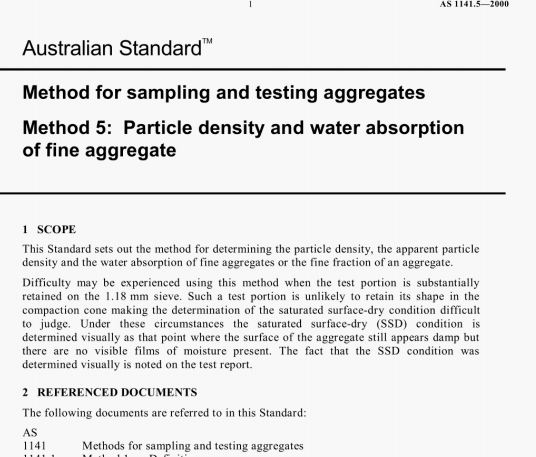AS 1141.5:2000 pdf – Method for sampling and testing aggregates Method 5: Particle density and water absorption of fine aggregate.
(b) Drain the water off the test portion and spread the aggregate on a flat impervious surface.
(C) Surface dry the aggregate by exposing it to a gently moving current of warm air and stirring it frequently to achieve uniform drying.
(d) When the aggregate appears to be free flowing, fill the conical mould by loosely placing part of the test portion in it. Tamp the surface of the aggregate with the tamping tool 25 times, allowing the tamping tool to fall from about 10 mm above the surface of the aggregate.
(e) Lift the conical mould vertically. If free moisture is present, the cone of fine aggregate will retain its shape. If the cone slumps on removal of the mould the first time, the aggregate is too dry and additional water will need to be added and the test portion allowed to stand for 30 mm.
(1) Continue drying with constant stirring and retest at frequent intervals using the procedure in Steps (d) and (e) until the cone of aggregate slumps on removal of the mould. Slumping of the aggregate cone indicates that it has reached a saturated surface-dry condition.
(g) Immediately after the saturated surface-dry condition has been achieved, determine the mass (in2) of the total test portion.
(h) Place the test portion into the volumetric flask or pycnomcter, as appropriate. Fill the flask to the 500 mL mark, or in such a manner that the same procedure used for determining the volume of the pycnometer has been followed (see Note). Determine the mass (in) of the flask and its contents.
NOTE: A pycnorneter with a stopper that has a constant volume niark included in the tube or pycnonieter with a flat ground top and lid has been found suitable.
(i) Top up the pycnometer with water and slide the lid on, or insert the stopper, making sure that no air bubbles are trapped. Dry the outside of the pycnorneter and lid. Determine the mass of the pycnometer plus lid, or stopper. plus aggregate plus water (mi).
NOTE: The mass of the pycnorncter tilled with water may be calibrated at regular intervals at the temperatures expected for the test or it may be determined immediately after the volume of aggregate has been determined.
(j) Remove the aggregate from the flask and place it in a dish, taking care not to lose any particles.
(k) Dry the aggregate in an oven at 105°C to 110°C to constant mass. Determine the mass (mi) of dry aggregate.
(l) Fill the flask with water at the same temperature as that measured in Step (j) and determine the mass of the filled flask.
AS 1141.5:2000 pdf – Method for sampling and testing aggregates Method 5: Particle density and water absorption of fine aggregate
